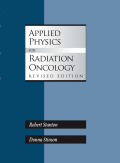
Applied Physics for Radiation Oncology, Revised Edition
Author: Robert Stanton and Donna StinsonISBN: 9781930524408
Published: 2009 | 292 pp. | Softcover
Price: $ 105.00
The Royal Australian and New Zealand College of Radiologists Website | Sep 2012
This text is intended as an introduction to radiation oncology physics for the radiation therapist, and as such, would be useful for students and those at the beginning of their career who are looking to expand and consolidate their physics knowledge. The basic physics chapters of this edition remain essentially unchanged from the earlier edition as the principles remain unchanged. Basic physics topics covered in this book include: matter and energy; radiation and its properties; the production of X-rays; radiation quality and X-ray and gamma–ray interactions with matter. There are then chapters discussing the principles of radiation detectors and determining radiation intensity in addition to reasons for using higher energy beams. The application of physics to radiation oncology treatment is then covered in chapters that cover the expected topics of linear accelerators, brachytherapy, treatment planning, radiation safety and photon and electron dosimetry.
Summary
The basic physics information is clearly and concisely explained, and as explained by the authors, has not changed significantly from the earlier edition of this text as the principles remain the same. Some of the later chapters however, such as Ch. 14 Treatment Planning and Ch. 15 Clinical Applications in Treatment Planning, would benefit from having more information on the newer techniques that are now becoming standard practice such as IGRT and IMRT, such that these topics are discussed to a similar level of detail as conformal planning.
This book contains several appendices with useful information for the student, such as a glossary, dosimetry tables and lists of radioactive nuclides, constants and units and signs and symbols that are used in radiation oncology physics. These appendices are clearly laid out and make finding this information fast and easy.
Black and white images and line drawings are interspersed with the text to provide clarification of the concepts described and are a welcome alternative to large blocks of text.
Discussion
Applied Physics for Radiation Oncology, Revised Edition, is successful in its aim to be a basic radiation physics text that introduces concepts to the student reader and provides useful information and reference material. The issues covered in each section are addressed well and there are both student objectives at the start of each chapter, and problems located at the end of chapters to test the understanding of the reader. The answers to the problems can be found in Appendix 4. For those readers that require more information on a given topic, there is a bibliography at the end of each chapter.
This book would be a useful reference for students; it is easy to find topics and concepts of interest and these are explained clearly and concisely. The standard of writing is appropriate to the topic and includes bold font throughout the text when key concepts are mentioned. This would assist students in appreciating the most important terms, and those that are explained further within the glossary, although it could be irritating or visually intrusive for other readers.
Conclusion
I would recommend this book to a student looking to increase their knowledge of radiation oncology physics. The text is informative and easy to read and describes fundamental concepts clearly and concisely. Due to this clear expression and easy to navigate structure, this book has achieved its stated goal of being an introduction to radiation therapy physics.
Aimee Lovett is a Senior Radiation Therapist at Royal Prince Alfred Hospital in Sydney and Senior Projects Officer (RT) at the Faculty of Radiation Oncology, Royal Australian and New Zealand College of Radiologists.


